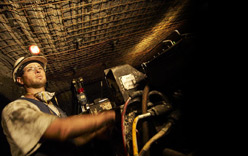Gas Control
Some mines do not have a gas problem of any type, the
quantity of gas in the coal being so low that only small percentages (or even
zero) are ever detected in the air. In such mines, other than continuously or
regularly checking gas levels to ensure conditions have not changed, no special
processes are required.
Note that this comment refers to naturally occurring
gas coming from the seam or surrounding strata. The ventilation system still
has to deal with introduced gases such as diesel exhaust, shotfiring fumes and
blackdamp (an atmosphere deficient in oxygen).
There are two ways of controlling gas levels in the
atmosphere within a mine:
- Provide sufficient air such that gas
concentrations in the air are always below levels which would create safety
issues (usually including a generous factor of safety).
- Capture the gas and contain it until
removed to a location where it is not a danger to the mine (usually in pipe
ranges or in boreholes).
Operationally, the first option is simplest as it does
not involve any additional mining procedure. Practically and financially there
are limits however, as an increase in the quantity of diluting air requires an
increased fan performance and/or additional roadways to reduce resistance. Both
of these come at a cost. Additional roadways may also require additional mining
units to maintain continuity of production (with longwalls particularly) and
this may then require additional ventilation of itself, compounding the
problem.
There are 4 ways of capturing/ containing gas to keep
it out of airways:
- Drilling boreholes into the coal seam
(possibly also in adjacent seams) prior to mining and connecting these to a
pipe range to remove any gas to a place where it can be dealt with, most
commonly the surface. Usually a vacuum is applied to the pipe range to enhance
gas capture. This process is known as "pre-drainage".
- Drilling boreholes in roof or floor strata
to capture gas released from the strata and flowing through it towards mine
airways. Such holes would normally be attached to a pipe range as for
pre-drainage. This process is known as "post drainage" as it captures gas released by the mining
process or "cross measure drainage" as the boreholes are drilled across the strata beds.
- Removing gas from live goaf areas, either
using pipes installed through goaf seals and attached to a pipe range as above
or by using boreholes drilled from surface down to strata just above the goaf.
Vacuum may be applied to such boreholes to assist in gas removal. This process
is known as "goaf drainage". The use of boreholes to surface may be limited by surface land use.
It should also be noted that even though reference is made to goaf "seals", it
is not possible to seal a live goaf as the face area must remain open until
mining is completed and the equipment removed.
- Sealing off worked out areas of the mine,
including standing goaf areas, to contain gas still being made within those
workings or goaf areas. Whilst there is always likely to be some leakage, high
quality seals may limit contamination of the mine ventilation. Flooding of
worked out areas is another effective way of controlling gas liberation,
however it may introduce other risks of inrush to future mine workings.
Note that these comments relate to controlling gas
levels in the airways. Gas drainage for the purpose of eliminating outbursts
may involve the same pre-drainage process as above but the target for gas
removal is only the area in which development roadways are to be driven. It may
also be the case that sufficient gas is pre-drained to avoid outbursts but the
remaining gas can still cause problems if released into the atmosphere.

